Having taken five Volkswagen Beetles and compressed them into spheres, artist Ichwan Noor was always going to grab attention at the inaugural Hong Kong Art Basel.
Noor is known in his native Indonesia but is hoping the glittering, champagne-soaked art fair will give him further recognition beyond his home borders.
Such are the opportunities that await emerging and lesser-known artists at the fair, which aims to highlight Hong Kong’s growing role as a global arts hub.
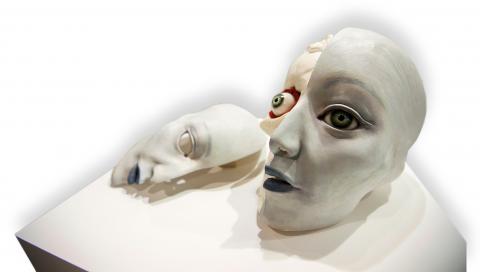
Photo: EPA
Soon after the event opened to guests on Wednesday, Noor saw one of his US$88,000 Beetle Spheres snapped up.
“Events like Hong Kong Art Basel will provide him (Noor) with the needed exposure,” Jakarta-based art museum and gallery Art:1 deputy director Monica Gunawan, said.
“He is quite well known in Jakarta, but not so much in the international art market.”
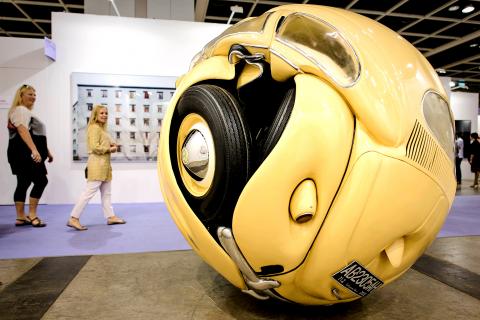
Photo: AFP
Works from more than 3,000 international artists have been exhibited through 245 of the world’s leading galleries, more than half of which are from Asia.
Buoyed by the arrival of so many well-heeled international collectors, galleries have competed with each other to hold lavish parties in the hope of attracting big-spending buyers.
At one event earlier this week supermodel Kate Moss was photographed sipping champagne with the likes Rupert Murdoch’s wife Wendi and Dasha Zhukova, the art collecting wife of billionaire Chelsea FC owner Roman Abramovich.
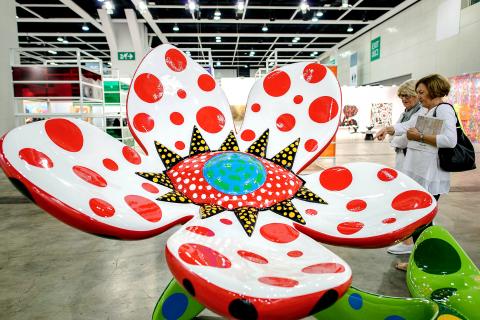
Photo: AFP
Henrietta Tsui, owner of local specialists Gallerie Ora-Ora and founder of the Hong Kong Art Gallery Association, has even taken guests out into Hong Kong’s Victoria Harbor on the family’s 80-foot yacht. She initially planned to hold a single event on the boat but had to make multiple trips because of demand.
“The response has been overwhelming, we were five times oversubscribed and we couldn’t accommodate all of them,” she said, adding that buyers came from all across the globe.
“It’s been fun at the back of the (exhibition) room trying to figure out all the different credit cards from around the world — that’s quite an indication of the kind of turnout,” she said.
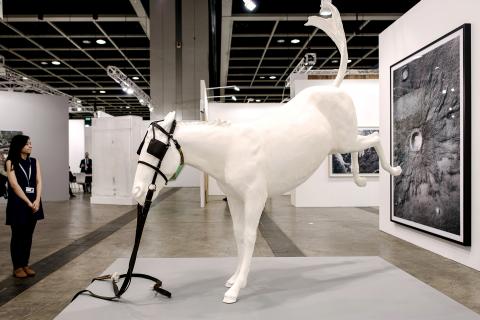
Photo: AFP
The four-day annual show, which ended last Sunday, has until now only been held in Switzerland and the United States and has made a dazzling debut in a city better known as a fast-paced financial hub.
Art:1, which is exhibiting in Hong Kong for the first time, is aiming to match up its artists with collectors who show long-term interest, Gunawan said.
“If we can get a good collector from here and maintain a long-term international relationship, it would be very good,” she said.
Collectors new to Hong Kong are looking to tap into the growing Asian market. Gagosian, White Cube, Acquavella, Lehmann Maupin and Galerie Perrotin are just some of the big-name galleries to have arrived in the city in the past two years despite sky-high rents.
Art Basel replaces Art HK, Hong Kong’s former art fair which was set up in 2008. It was recently taken over by the high-profile Swiss Art Basel franchise, which has been showcasing modern and contemporary art since 1970.
The event also featured local Hong Kong artists such as Lam Tung-pang who showcased his One-Two-World, an installation where scale models, plants and drawings were projected on paper.
Also on display were five works including video and three-dimensional installations using day-to-day items by Lam’s compatriot Tang Kwok-hin (鄧國騫).
“I’m here to see if there’s anything new to pick up, maybe Asian artists that I’m not so familiar with or we don’t see as much in Europe or in the States,” said Garance Massart, who directs a Switzerland-based art consultancy.
“You have emerging artists, you have very established impressionists, modern Picassos for multimillion dollar numbers and maybe five stands behind you’ll have a 15,000 euro artist that’s not as famous,” Massart said of the fair’s selection.
With its international status, convenient location as an Asian hub and a large selection of leading galleries compared to other city centers in Asia, “it makes sense” to have the fair in Hong Kong, said Massart.
“I think the wealth is growing and so is the market,” she said.
The former British colony has surged to third place in the global art auction market behind New York and London.
The boom in Hong Kong’s international art market is largely a result of the fast-growing wealth of mainland Chinese, some of whom are investing heavily in art.
There has also been a growing interest among Chinese and Asian collectors for different types of international art aside from traditional works.
“Just seeing the growth in China of the new collectors ... it’s just good that they are starting to open themselves to art,” said Melanie Ouyang Lum, an art consultant based in Los Angeles looking for up and coming works at the fair.
“There’s a lot of Chinese collectors who are going abroad now and going to a lot of the fairs ... and starting to educate themselves about art,” Lum, who has been working extensively with Chinese artists for the past five years, said.
“I think that’s a springboard and they will influence the younger generation,” she said.
With a younger and more affluent generation of Chinese collectors being more involved in the art scene, the Asian art market could become very lucrative, Lum said.
“I think the sky’s the limit.”
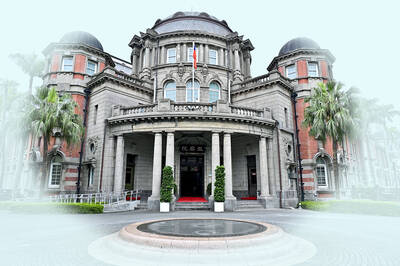
The Taipei Times last week reported that the Control Yuan said it had been “left with no choice” but to ask the Constitutional Court to rule on the constitutionality of the central government budget, which left it without a budget. Lost in the outrage over the cuts to defense and to the Constitutional Court were the cuts to the Control Yuan, whose operating budget was slashed by 96 percent. It is unable even to pay its utility bills, and in the press conference it convened on the issue, said that its department directors were paying out of pocket for gasoline

On March 13 President William Lai (賴清德) gave a national security speech noting the 20th year since the passing of China’s Anti-Secession Law (反分裂國家法) in March 2005 that laid the legal groundwork for an invasion of Taiwan. That law, and other subsequent ones, are merely political theater created by the Chinese Communist Party (CCP) to have something to point to so they can claim “we have to do it, it is the law.” The president’s speech was somber and said: “By its actions, China already satisfies the definition of a ‘foreign hostile force’ as provided in the Anti-Infiltration Act, which unlike

That US assistance was a model for Taiwan’s spectacular development success was early recognized by policymakers and analysts. In a report to the US Congress for the fiscal year 1962, former President John F. Kennedy noted Taiwan’s “rapid economic growth,” was “producing a substantial net gain in living.” Kennedy had a stake in Taiwan’s achievements and the US’ official development assistance (ODA) in general: In September 1961, his entreaty to make the 1960s a “decade of development,” and an accompanying proposal for dedicated legislation to this end, had been formalized by congressional passage of the Foreign Assistance Act. Two

Despite the intense sunshine, we were hardly breaking a sweat as we cruised along the flat, dedicated bike lane, well protected from the heat by a canopy of trees. The electric assist on the bikes likely made a difference, too. Far removed from the bustle and noise of the Taichung traffic, we admired the serene rural scenery, making our way over rivers, alongside rice paddies and through pear orchards. Our route for the day covered two bike paths that connect in Fengyuan District (豐原) and are best done together. The Hou-Feng Bike Path (后豐鐵馬道) runs southward from Houli District (后里) while the